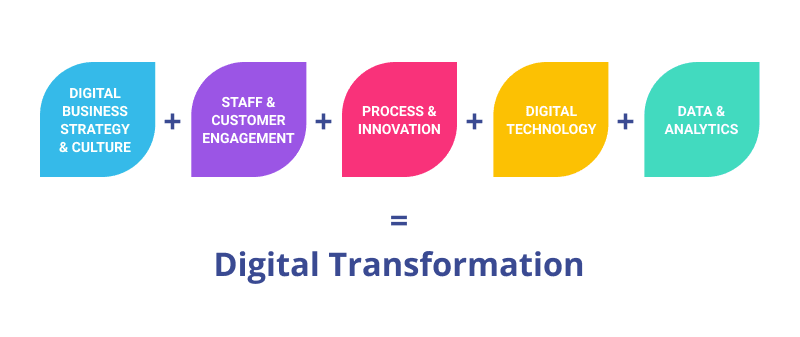What Are The 6 Core Elements of Digital Transformation?
Digital transformation is much more than just bringing your business to digital platforms. If you want impactful changes in the way, you operate the business while preventing risks, then digital transformation is for you.
According to a report by results and market, the digital transformation market is expanding rapidly and is expected to cross USD 3.3 billion by 2025. But there is a noticeable gap between those implementing digital transformation and those who are seriously succeeding in it. The question is what makes the difference and the answer is the 6 core elements that are mentioned below.
*1. Innovation using technology *
While talking about digital transformation, technology cannot be exempted. Choosing the most suitable technology is the most crucial step for the digital transformation of your business. Here are some new-age technologies that can be embedded in your business:
*- Artificial Intelligence and data analytics *
AI-based technologies, such as machine learning, deep learning, and natural language processing help companies in smooth operations and better decision-making. The huge data generated is used for future-ready machines that will take over decision-making from humans and make real-time decisions to scale. Organizations can reduce risk by predicting a scenario using AI-enabled tools, and improve customer experience by reducing response time with AI-powered assistants.
*- Cloud-based Technologies *
The aim is hyper-automation so that human capabilities can be used in developing other value-adding products. Using cloud technologies, organizations can improve agility, operations, security, and achieve high scalability. Other useful technologies to include are an extended reality, blockchain, 5G, etc.
*2. Prioritize Customer experience *
As per Mckinsey, digital transformation can boost 20%-50% economic gains and 20%-30% more client satisfaction. Prioritize making the customer experience the base of any investment. Do not expect customers to fit your business criteria instead make your processes such that they fit your customer’s shoes.
For instance, companies like Apple, Starbucks, and Nike focused on customer experiences and thus are the leading companies in their industries. So, focus on developing deep bonds with your customers and solving their problems.
*3. Bring the right mindset to business with LEADERSHIP *
Leadership is the base of a strong foundation. Digital leadership is something that links all four aspects including network, trust, team, and decentralized organization. So, when you select a leader for a group, identify these qualities in them:
- Ability to explore, experiment, and have the flexibility to take risks.
- Become digitally strong.
- Understand the role of technology in social transformation and use this to enhance business.
- Encourage collaboration and innovation in environments.
- Ability to analyze complete information and not just technology.
With this transition from leadership to digital leadership, digital transformation in business will be easy and quick.
*4. Reorganize the existing business model *
For digital transformation, it is necessary to bring innovation in procedures, costs, processes, and product management to your existing model. In a traditional IT setup, there were basically two phases: the development phase and the testing and deployment phase.
But modern agile setup combines all these elements in one cross-functional team. Using agile technology, development is done in sprints thus, ensuring consistent customer feedback and fast implementation.
Organizations opt for DevOps practices to automate optimize processes to fast, reliable, and better products.
*5. Data-focus *
Data and metrics are the best fuel for perfect decision-making. As per a report, 88% of companies with measured high digital maturity with data-focused usage. Using AI and machine learning in your processes yields nothing if the data they generate is not used and analyzed properly.
Data analysis and integration can be used to identify the pain points of your customers and employees and use them to build transformational strategies. Finding the loopholes in customers' data will help you identify the best solutions for them and build the best transformative products.
*6. Team structure *
According to International Data Corporation market research, "by 2024, 55 percent of successful digitally innovative products will be built by teams that include people with a creative mind, critical thinking, analysis, and automation skills." The creative and skilled team will be able to pull off the successful digital transformation. So, structuring your team is important.
Design your team structure as per the project size and include the following:
- Team leader: Consider this as an agile leader that you can appoint for accountability.
- Business Leader: Manager who can relate to technology and business processes to make a balance.
- Coders and Designers: Skilled force for development and designer to work together.
Your end goal is high performing team so focus on great teamwork and communication.
*Digital Transformation On Your Way *
Now as you know what core elements you should focus on, it's time for implementation. Develop a digital transformation strategy that includes: your goals, market levels, competitor analysis, existing and targeted customers, and required resources. It's better today than tomorrow. As of now, you have the key to start transforming your business digitally. So go and execute it. All the best!
